Marketing Strategies of Travel Companies: A Comparative Analysis
VerifiedAdded on 2023/01/16
|16
|4396
|23
Report
AI Summary
This report offers a comprehensive analysis of the marketing strategies employed by three travel companies: ROCS Group, FCM Solutions, and Britannia Tours. The analysis is based on a marketing consultancy project conducted for a client in the travel industry. The report examines the application of key marketing concepts, including market segmentation, target marketing, product positioning, differentiation, and customer-driven marketing strategies. It provides a comparative critical analysis of the campaigns, highlighting how each company utilizes these concepts to reach its target audience. The report focuses on specific campaigns, such as ROCS's London travel package, FCM's Fjords Cruise package, and Britannia Tours' Summer in Lourdes, evaluating their effectiveness in the context of the chosen marketing concepts. The analysis considers the companies' overviews, market segments, target segments, product positioning, differentiation strategies, and customer-driven approaches, providing valuable insights into their marketing practices and campaign effectiveness. The report follows the structure of the assignment brief, ensuring a thorough and detailed evaluation of the selected campaigns.
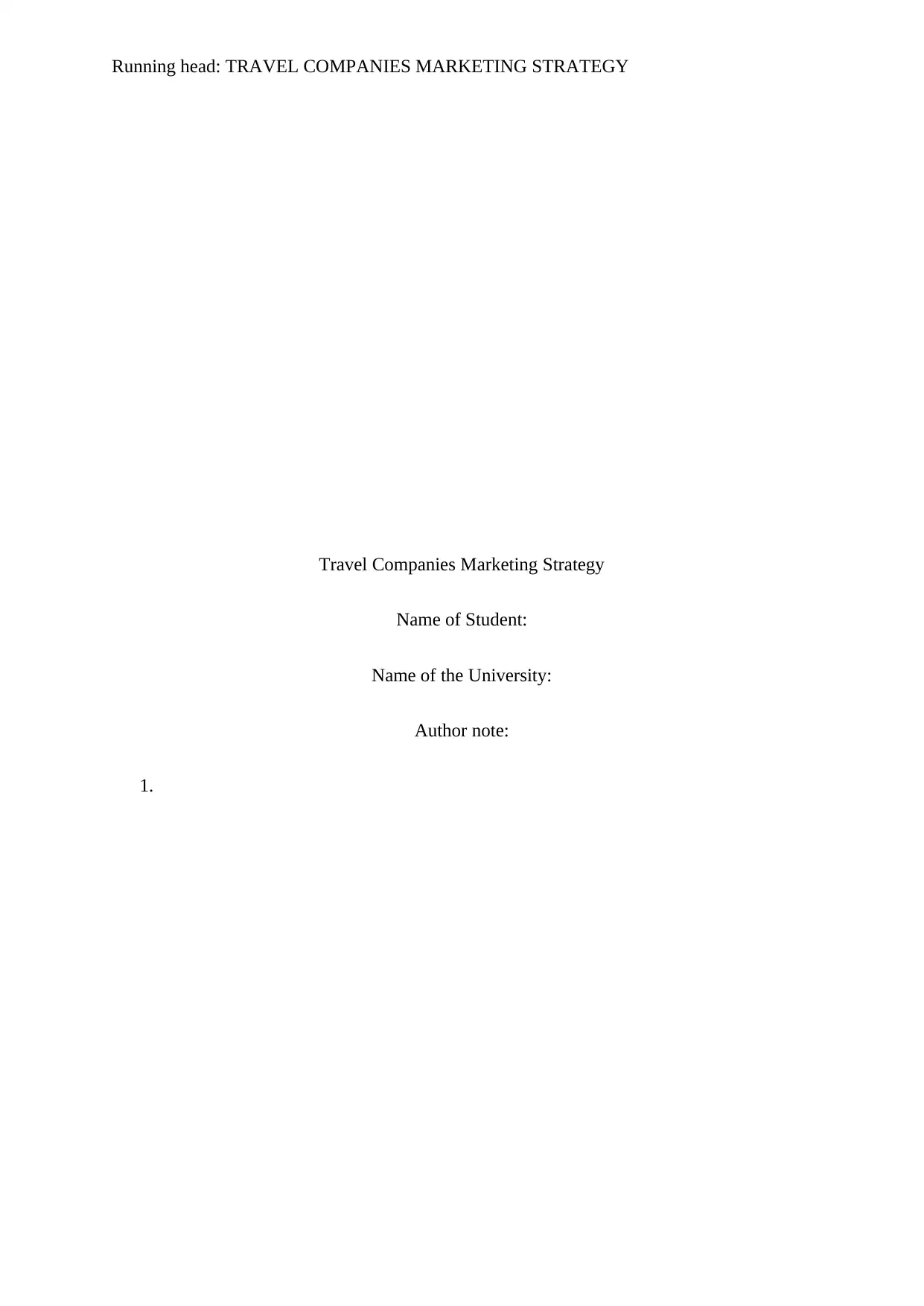
Running head: TRAVEL COMPANIES MARKETING STRATEGY
Travel Companies Marketing Strategy
Name of Student:
Name of the University:
Author note:
1.
Travel Companies Marketing Strategy
Name of Student:
Name of the University:
Author note:
1.
Paraphrase This Document
Need a fresh take? Get an instant paraphrase of this document with our AI Paraphraser
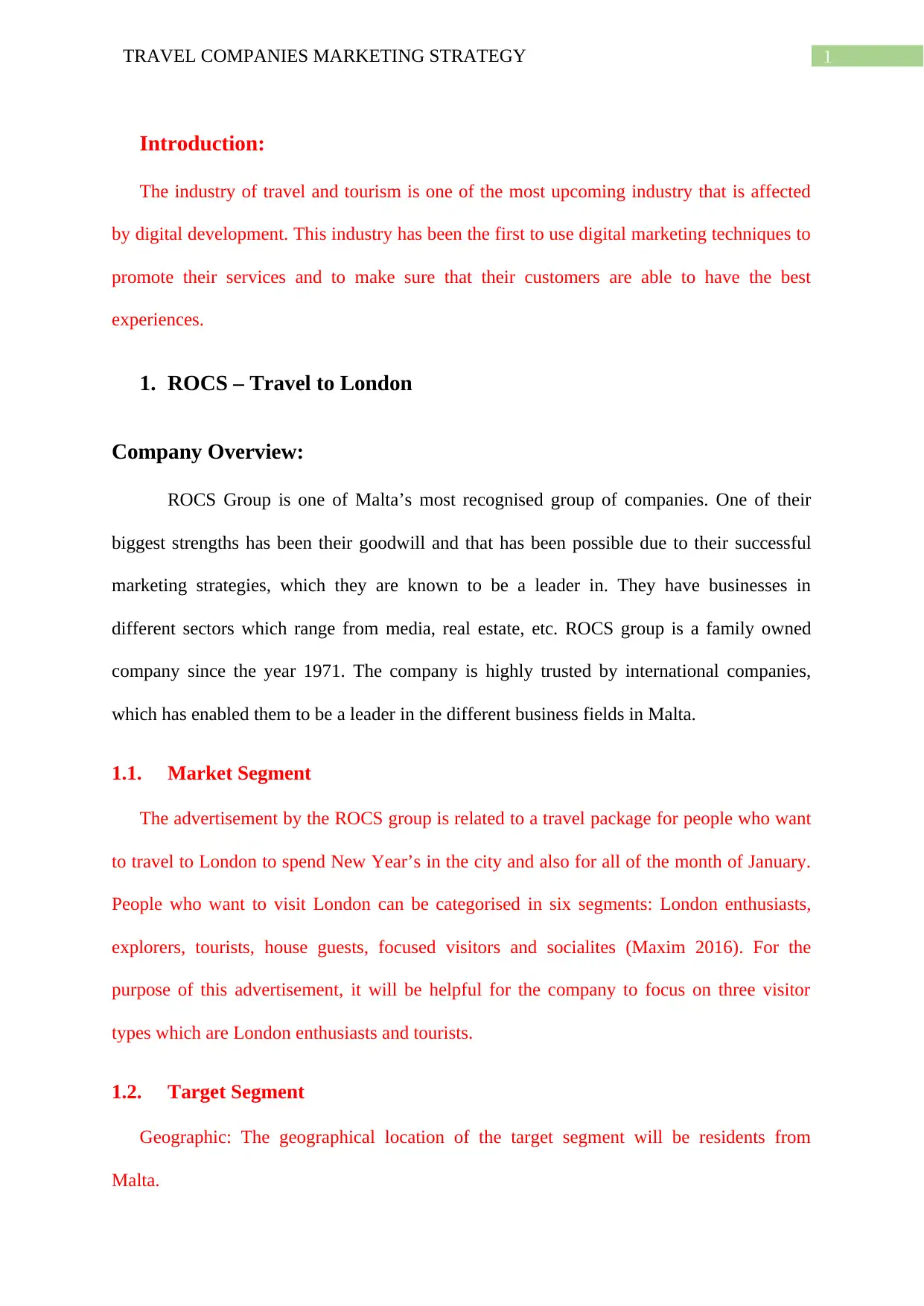
1TRAVEL COMPANIES MARKETING STRATEGY
Introduction:
The industry of travel and tourism is one of the most upcoming industry that is affected
by digital development. This industry has been the first to use digital marketing techniques to
promote their services and to make sure that their customers are able to have the best
experiences.
1. ROCS – Travel to London
Company Overview:
ROCS Group is one of Malta’s most recognised group of companies. One of their
biggest strengths has been their goodwill and that has been possible due to their successful
marketing strategies, which they are known to be a leader in. They have businesses in
different sectors which range from media, real estate, etc. ROCS group is a family owned
company since the year 1971. The company is highly trusted by international companies,
which has enabled them to be a leader in the different business fields in Malta.
1.1. Market Segment
The advertisement by the ROCS group is related to a travel package for people who want
to travel to London to spend New Year’s in the city and also for all of the month of January.
People who want to visit London can be categorised in six segments: London enthusiasts,
explorers, tourists, house guests, focused visitors and socialites (Maxim 2016). For the
purpose of this advertisement, it will be helpful for the company to focus on three visitor
types which are London enthusiasts and tourists.
1.2. Target Segment
Geographic: The geographical location of the target segment will be residents from
Malta.
Introduction:
The industry of travel and tourism is one of the most upcoming industry that is affected
by digital development. This industry has been the first to use digital marketing techniques to
promote their services and to make sure that their customers are able to have the best
experiences.
1. ROCS – Travel to London
Company Overview:
ROCS Group is one of Malta’s most recognised group of companies. One of their
biggest strengths has been their goodwill and that has been possible due to their successful
marketing strategies, which they are known to be a leader in. They have businesses in
different sectors which range from media, real estate, etc. ROCS group is a family owned
company since the year 1971. The company is highly trusted by international companies,
which has enabled them to be a leader in the different business fields in Malta.
1.1. Market Segment
The advertisement by the ROCS group is related to a travel package for people who want
to travel to London to spend New Year’s in the city and also for all of the month of January.
People who want to visit London can be categorised in six segments: London enthusiasts,
explorers, tourists, house guests, focused visitors and socialites (Maxim 2016). For the
purpose of this advertisement, it will be helpful for the company to focus on three visitor
types which are London enthusiasts and tourists.
1.2. Target Segment
Geographic: The geographical location of the target segment will be residents from
Malta.
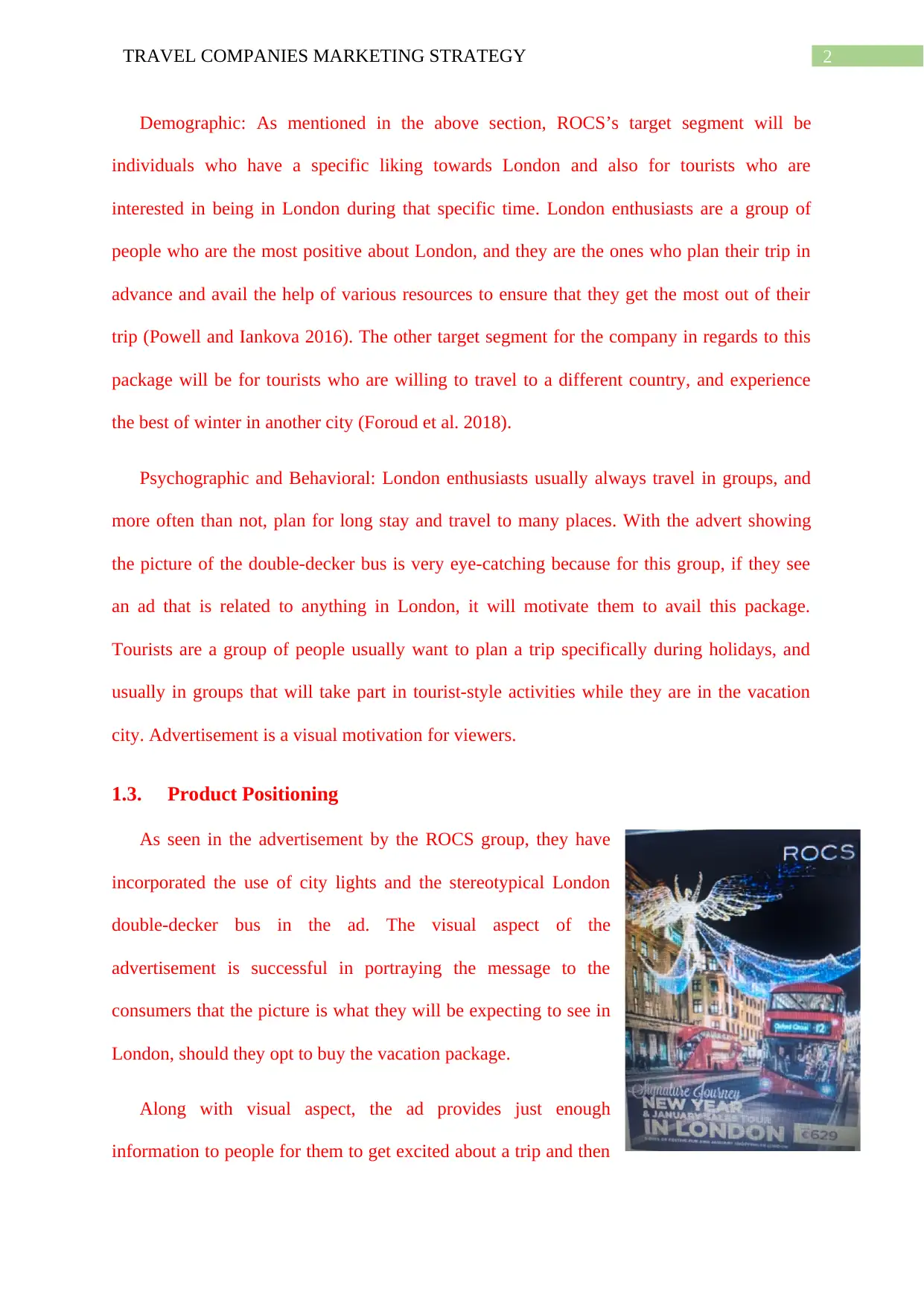
2TRAVEL COMPANIES MARKETING STRATEGY
Demographic: As mentioned in the above section, ROCS’s target segment will be
individuals who have a specific liking towards London and also for tourists who are
interested in being in London during that specific time. London enthusiasts are a group of
people who are the most positive about London, and they are the ones who plan their trip in
advance and avail the help of various resources to ensure that they get the most out of their
trip (Powell and Iankova 2016). The other target segment for the company in regards to this
package will be for tourists who are willing to travel to a different country, and experience
the best of winter in another city (Foroud et al. 2018).
Psychographic and Behavioral: London enthusiasts usually always travel in groups, and
more often than not, plan for long stay and travel to many places. With the advert showing
the picture of the double-decker bus is very eye-catching because for this group, if they see
an ad that is related to anything in London, it will motivate them to avail this package.
Tourists are a group of people usually want to plan a trip specifically during holidays, and
usually in groups that will take part in tourist-style activities while they are in the vacation
city. Advertisement is a visual motivation for viewers.
1.3. Product Positioning
As seen in the advertisement by the ROCS group, they have
incorporated the use of city lights and the stereotypical London
double-decker bus in the ad. The visual aspect of the
advertisement is successful in portraying the message to the
consumers that the picture is what they will be expecting to see in
London, should they opt to buy the vacation package.
Along with visual aspect, the ad provides just enough
information to people for them to get excited about a trip and then
Demographic: As mentioned in the above section, ROCS’s target segment will be
individuals who have a specific liking towards London and also for tourists who are
interested in being in London during that specific time. London enthusiasts are a group of
people who are the most positive about London, and they are the ones who plan their trip in
advance and avail the help of various resources to ensure that they get the most out of their
trip (Powell and Iankova 2016). The other target segment for the company in regards to this
package will be for tourists who are willing to travel to a different country, and experience
the best of winter in another city (Foroud et al. 2018).
Psychographic and Behavioral: London enthusiasts usually always travel in groups, and
more often than not, plan for long stay and travel to many places. With the advert showing
the picture of the double-decker bus is very eye-catching because for this group, if they see
an ad that is related to anything in London, it will motivate them to avail this package.
Tourists are a group of people usually want to plan a trip specifically during holidays, and
usually in groups that will take part in tourist-style activities while they are in the vacation
city. Advertisement is a visual motivation for viewers.
1.3. Product Positioning
As seen in the advertisement by the ROCS group, they have
incorporated the use of city lights and the stereotypical London
double-decker bus in the ad. The visual aspect of the
advertisement is successful in portraying the message to the
consumers that the picture is what they will be expecting to see in
London, should they opt to buy the vacation package.
Along with visual aspect, the ad provides just enough
information to people for them to get excited about a trip and then
⊘ This is a preview!⊘
Do you want full access?
Subscribe today to unlock all pages.

Trusted by 1+ million students worldwide
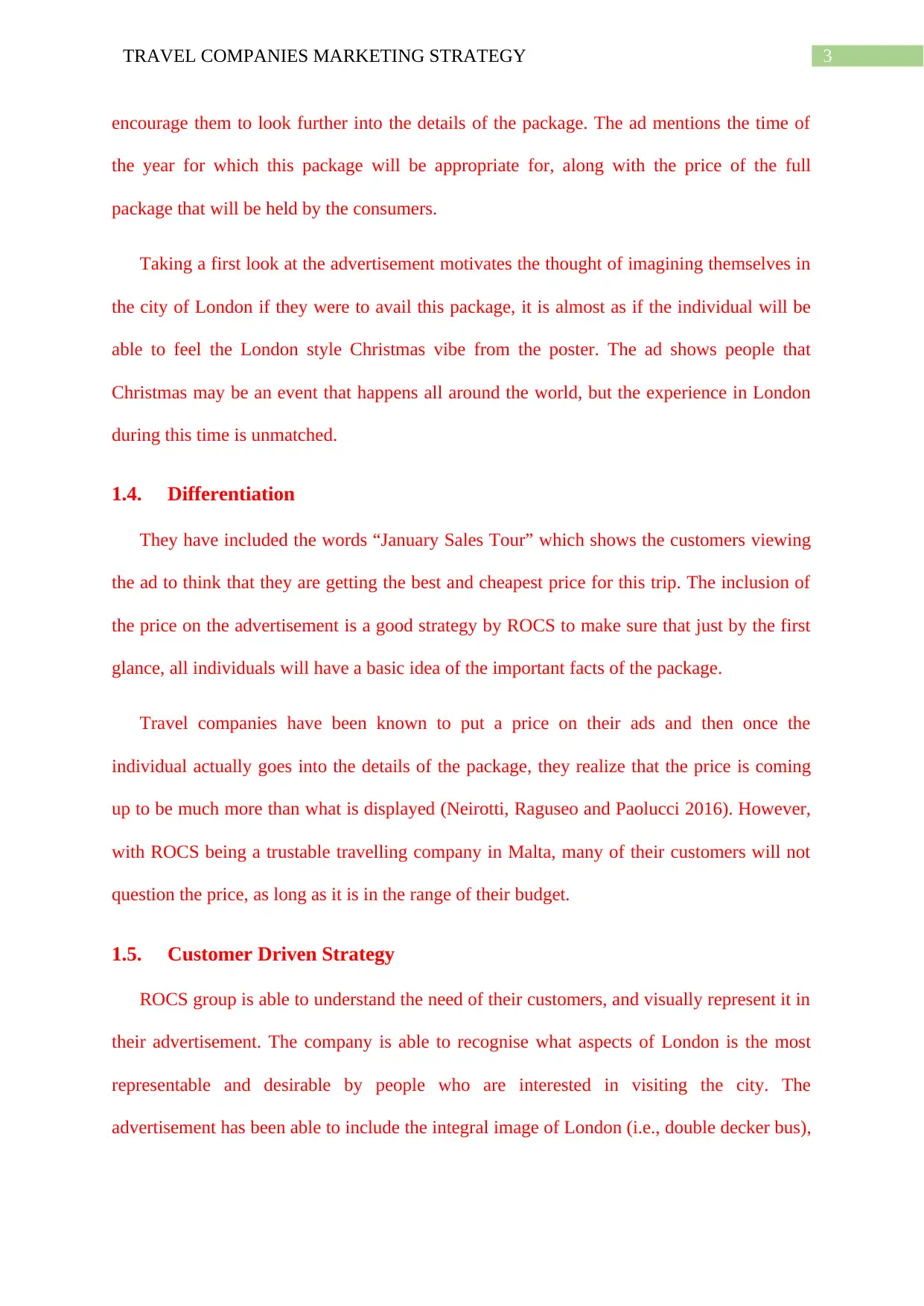
3TRAVEL COMPANIES MARKETING STRATEGY
encourage them to look further into the details of the package. The ad mentions the time of
the year for which this package will be appropriate for, along with the price of the full
package that will be held by the consumers.
Taking a first look at the advertisement motivates the thought of imagining themselves in
the city of London if they were to avail this package, it is almost as if the individual will be
able to feel the London style Christmas vibe from the poster. The ad shows people that
Christmas may be an event that happens all around the world, but the experience in London
during this time is unmatched.
1.4. Differentiation
They have included the words “January Sales Tour” which shows the customers viewing
the ad to think that they are getting the best and cheapest price for this trip. The inclusion of
the price on the advertisement is a good strategy by ROCS to make sure that just by the first
glance, all individuals will have a basic idea of the important facts of the package.
Travel companies have been known to put a price on their ads and then once the
individual actually goes into the details of the package, they realize that the price is coming
up to be much more than what is displayed (Neirotti, Raguseo and Paolucci 2016). However,
with ROCS being a trustable travelling company in Malta, many of their customers will not
question the price, as long as it is in the range of their budget.
1.5. Customer Driven Strategy
ROCS group is able to understand the need of their customers, and visually represent it in
their advertisement. The company is able to recognise what aspects of London is the most
representable and desirable by people who are interested in visiting the city. The
advertisement has been able to include the integral image of London (i.e., double decker bus),
encourage them to look further into the details of the package. The ad mentions the time of
the year for which this package will be appropriate for, along with the price of the full
package that will be held by the consumers.
Taking a first look at the advertisement motivates the thought of imagining themselves in
the city of London if they were to avail this package, it is almost as if the individual will be
able to feel the London style Christmas vibe from the poster. The ad shows people that
Christmas may be an event that happens all around the world, but the experience in London
during this time is unmatched.
1.4. Differentiation
They have included the words “January Sales Tour” which shows the customers viewing
the ad to think that they are getting the best and cheapest price for this trip. The inclusion of
the price on the advertisement is a good strategy by ROCS to make sure that just by the first
glance, all individuals will have a basic idea of the important facts of the package.
Travel companies have been known to put a price on their ads and then once the
individual actually goes into the details of the package, they realize that the price is coming
up to be much more than what is displayed (Neirotti, Raguseo and Paolucci 2016). However,
with ROCS being a trustable travelling company in Malta, many of their customers will not
question the price, as long as it is in the range of their budget.
1.5. Customer Driven Strategy
ROCS group is able to understand the need of their customers, and visually represent it in
their advertisement. The company is able to recognise what aspects of London is the most
representable and desirable by people who are interested in visiting the city. The
advertisement has been able to include the integral image of London (i.e., double decker bus),
Paraphrase This Document
Need a fresh take? Get an instant paraphrase of this document with our AI Paraphraser
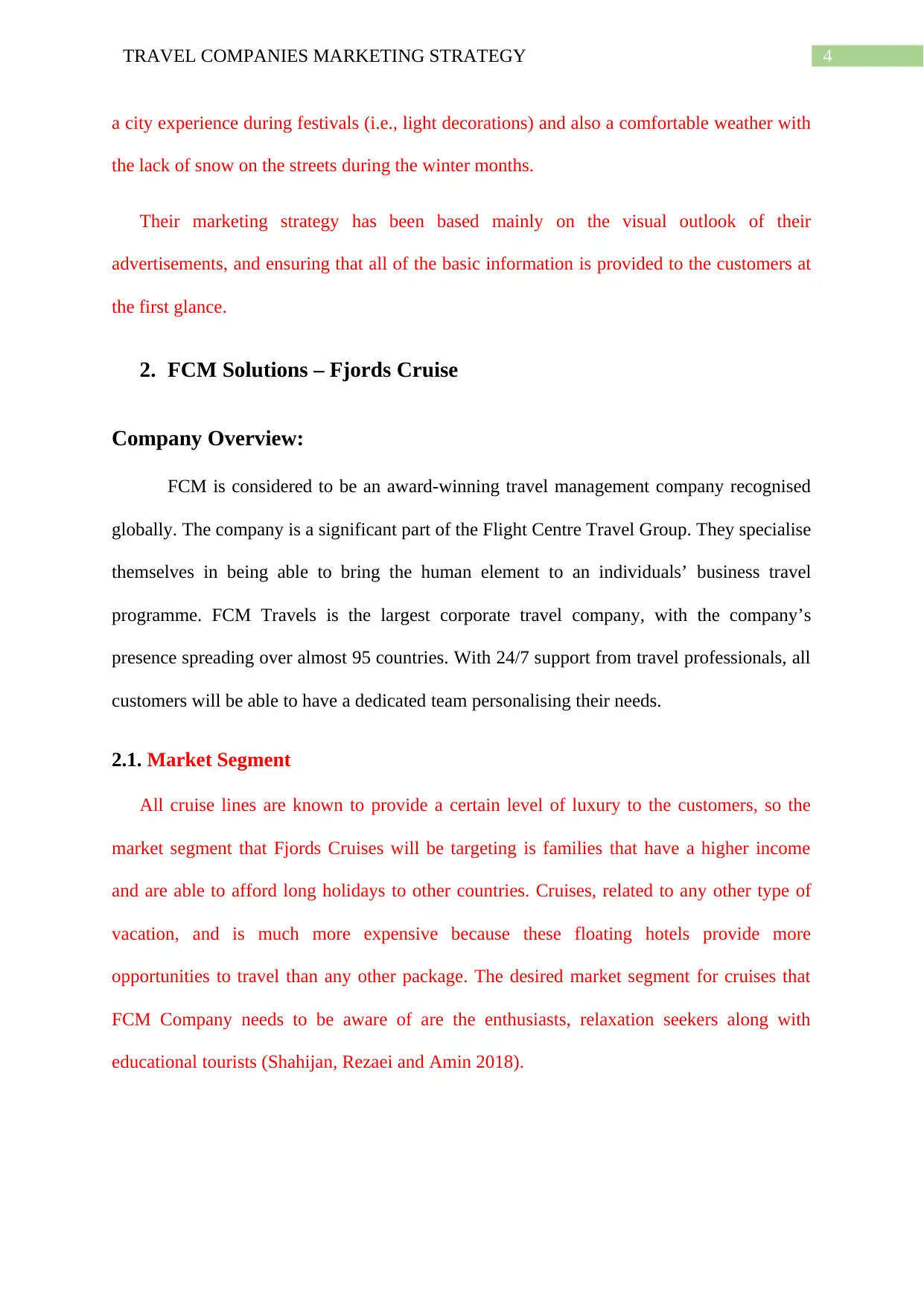
4TRAVEL COMPANIES MARKETING STRATEGY
a city experience during festivals (i.e., light decorations) and also a comfortable weather with
the lack of snow on the streets during the winter months.
Their marketing strategy has been based mainly on the visual outlook of their
advertisements, and ensuring that all of the basic information is provided to the customers at
the first glance.
2. FCM Solutions – Fjords Cruise
Company Overview:
FCM is considered to be an award-winning travel management company recognised
globally. The company is a significant part of the Flight Centre Travel Group. They specialise
themselves in being able to bring the human element to an individuals’ business travel
programme. FCM Travels is the largest corporate travel company, with the company’s
presence spreading over almost 95 countries. With 24/7 support from travel professionals, all
customers will be able to have a dedicated team personalising their needs.
2.1. Market Segment
All cruise lines are known to provide a certain level of luxury to the customers, so the
market segment that Fjords Cruises will be targeting is families that have a higher income
and are able to afford long holidays to other countries. Cruises, related to any other type of
vacation, and is much more expensive because these floating hotels provide more
opportunities to travel than any other package. The desired market segment for cruises that
FCM Company needs to be aware of are the enthusiasts, relaxation seekers along with
educational tourists (Shahijan, Rezaei and Amin 2018).
a city experience during festivals (i.e., light decorations) and also a comfortable weather with
the lack of snow on the streets during the winter months.
Their marketing strategy has been based mainly on the visual outlook of their
advertisements, and ensuring that all of the basic information is provided to the customers at
the first glance.
2. FCM Solutions – Fjords Cruise
Company Overview:
FCM is considered to be an award-winning travel management company recognised
globally. The company is a significant part of the Flight Centre Travel Group. They specialise
themselves in being able to bring the human element to an individuals’ business travel
programme. FCM Travels is the largest corporate travel company, with the company’s
presence spreading over almost 95 countries. With 24/7 support from travel professionals, all
customers will be able to have a dedicated team personalising their needs.
2.1. Market Segment
All cruise lines are known to provide a certain level of luxury to the customers, so the
market segment that Fjords Cruises will be targeting is families that have a higher income
and are able to afford long holidays to other countries. Cruises, related to any other type of
vacation, and is much more expensive because these floating hotels provide more
opportunities to travel than any other package. The desired market segment for cruises that
FCM Company needs to be aware of are the enthusiasts, relaxation seekers along with
educational tourists (Shahijan, Rezaei and Amin 2018).
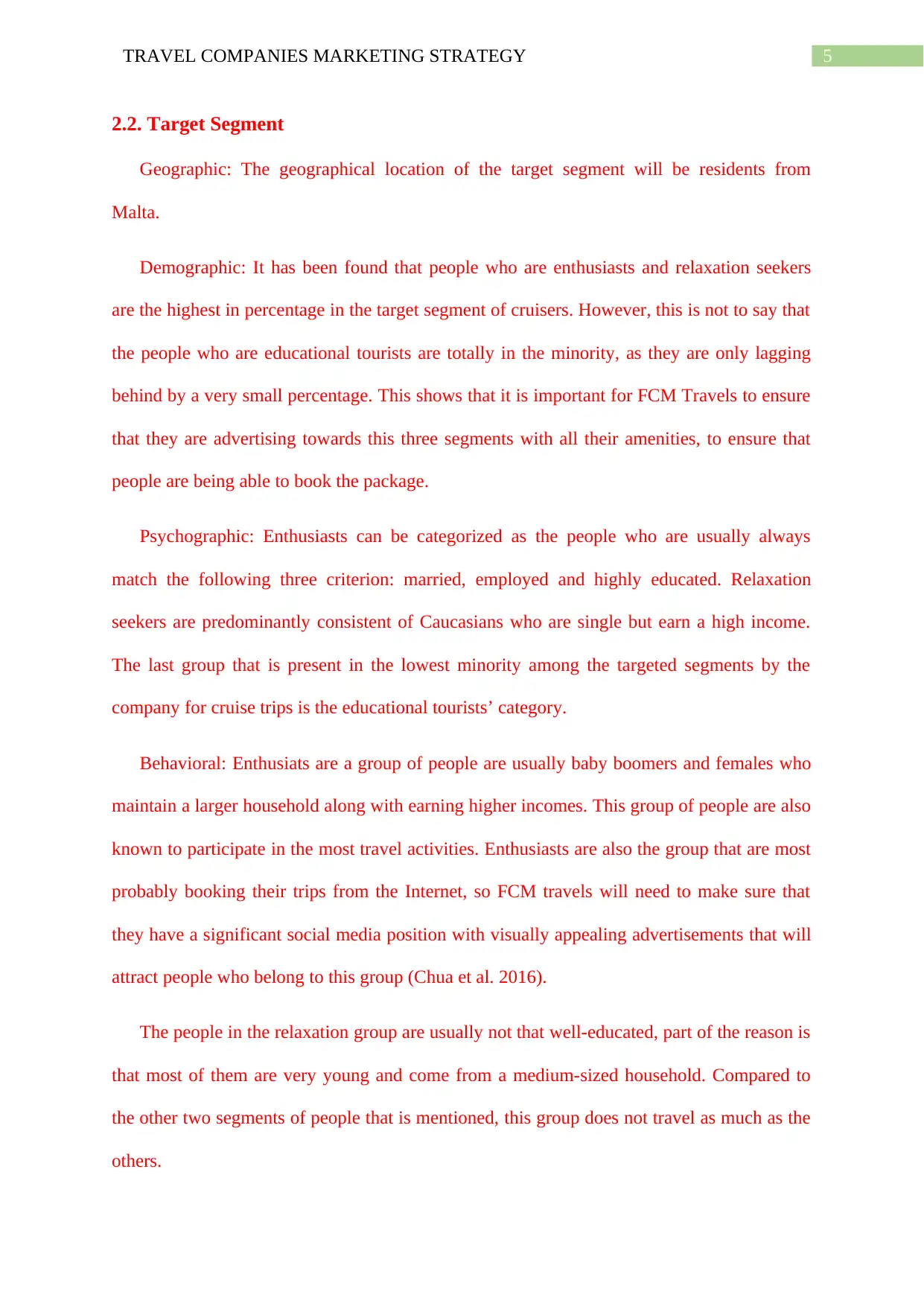
5TRAVEL COMPANIES MARKETING STRATEGY
2.2. Target Segment
Geographic: The geographical location of the target segment will be residents from
Malta.
Demographic: It has been found that people who are enthusiasts and relaxation seekers
are the highest in percentage in the target segment of cruisers. However, this is not to say that
the people who are educational tourists are totally in the minority, as they are only lagging
behind by a very small percentage. This shows that it is important for FCM Travels to ensure
that they are advertising towards this three segments with all their amenities, to ensure that
people are being able to book the package.
Psychographic: Enthusiasts can be categorized as the people who are usually always
match the following three criterion: married, employed and highly educated. Relaxation
seekers are predominantly consistent of Caucasians who are single but earn a high income.
The last group that is present in the lowest minority among the targeted segments by the
company for cruise trips is the educational tourists’ category.
Behavioral: Enthusiats are a group of people are usually baby boomers and females who
maintain a larger household along with earning higher incomes. This group of people are also
known to participate in the most travel activities. Enthusiasts are also the group that are most
probably booking their trips from the Internet, so FCM travels will need to make sure that
they have a significant social media position with visually appealing advertisements that will
attract people who belong to this group (Chua et al. 2016).
The people in the relaxation group are usually not that well-educated, part of the reason is
that most of them are very young and come from a medium-sized household. Compared to
the other two segments of people that is mentioned, this group does not travel as much as the
others.
2.2. Target Segment
Geographic: The geographical location of the target segment will be residents from
Malta.
Demographic: It has been found that people who are enthusiasts and relaxation seekers
are the highest in percentage in the target segment of cruisers. However, this is not to say that
the people who are educational tourists are totally in the minority, as they are only lagging
behind by a very small percentage. This shows that it is important for FCM Travels to ensure
that they are advertising towards this three segments with all their amenities, to ensure that
people are being able to book the package.
Psychographic: Enthusiasts can be categorized as the people who are usually always
match the following three criterion: married, employed and highly educated. Relaxation
seekers are predominantly consistent of Caucasians who are single but earn a high income.
The last group that is present in the lowest minority among the targeted segments by the
company for cruise trips is the educational tourists’ category.
Behavioral: Enthusiats are a group of people are usually baby boomers and females who
maintain a larger household along with earning higher incomes. This group of people are also
known to participate in the most travel activities. Enthusiasts are also the group that are most
probably booking their trips from the Internet, so FCM travels will need to make sure that
they have a significant social media position with visually appealing advertisements that will
attract people who belong to this group (Chua et al. 2016).
The people in the relaxation group are usually not that well-educated, part of the reason is
that most of them are very young and come from a medium-sized household. Compared to
the other two segments of people that is mentioned, this group does not travel as much as the
others.
⊘ This is a preview!⊘
Do you want full access?
Subscribe today to unlock all pages.

Trusted by 1+ million students worldwide
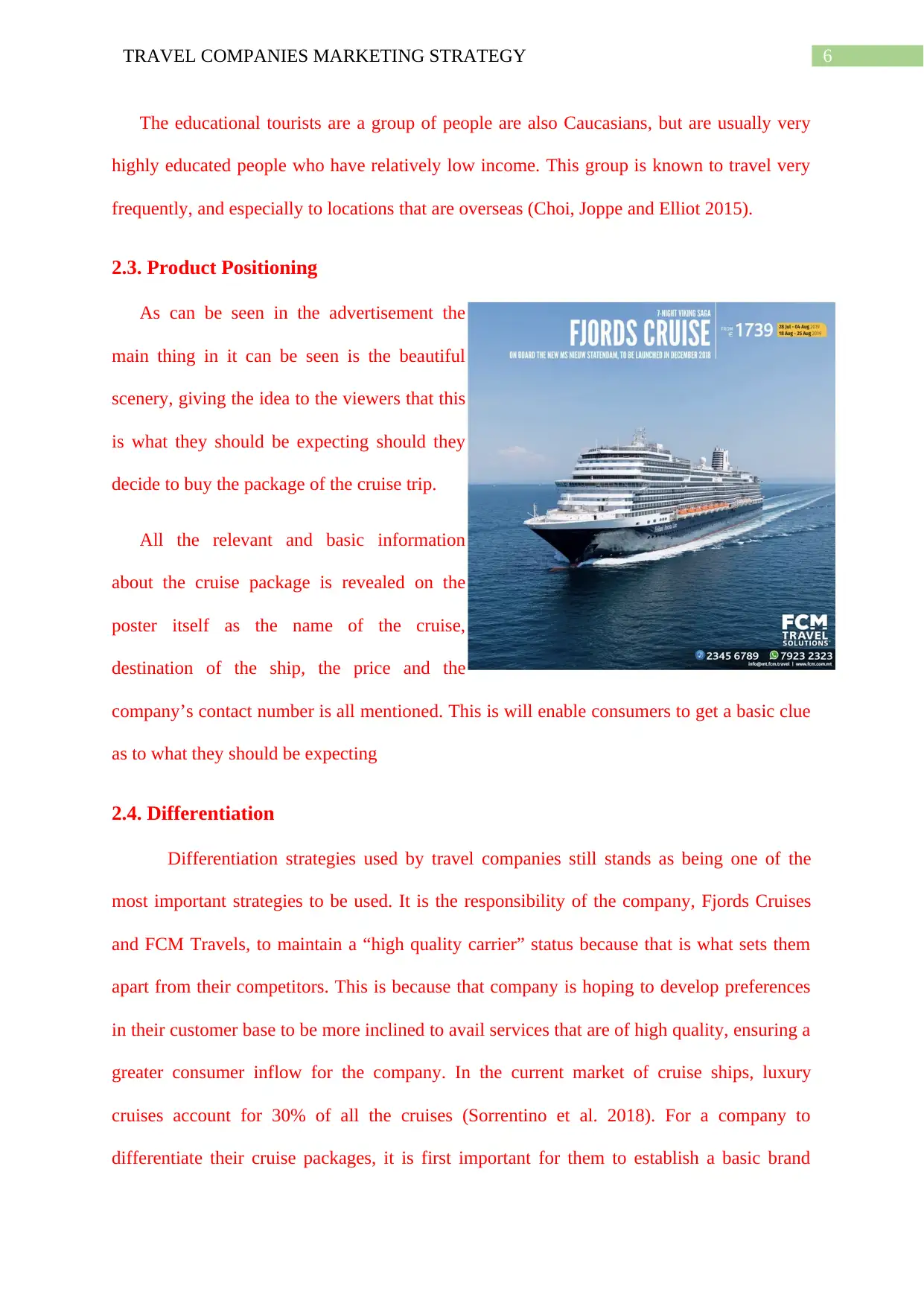
6TRAVEL COMPANIES MARKETING STRATEGY
The educational tourists are a group of people are also Caucasians, but are usually very
highly educated people who have relatively low income. This group is known to travel very
frequently, and especially to locations that are overseas (Choi, Joppe and Elliot 2015).
2.3. Product Positioning
As can be seen in the advertisement the
main thing in it can be seen is the beautiful
scenery, giving the idea to the viewers that this
is what they should be expecting should they
decide to buy the package of the cruise trip.
All the relevant and basic information
about the cruise package is revealed on the
poster itself as the name of the cruise,
destination of the ship, the price and the
company’s contact number is all mentioned. This is will enable consumers to get a basic clue
as to what they should be expecting
2.4. Differentiation
Differentiation strategies used by travel companies still stands as being one of the
most important strategies to be used. It is the responsibility of the company, Fjords Cruises
and FCM Travels, to maintain a “high quality carrier” status because that is what sets them
apart from their competitors. This is because that company is hoping to develop preferences
in their customer base to be more inclined to avail services that are of high quality, ensuring a
greater consumer inflow for the company. In the current market of cruise ships, luxury
cruises account for 30% of all the cruises (Sorrentino et al. 2018). For a company to
differentiate their cruise packages, it is first important for them to establish a basic brand
The educational tourists are a group of people are also Caucasians, but are usually very
highly educated people who have relatively low income. This group is known to travel very
frequently, and especially to locations that are overseas (Choi, Joppe and Elliot 2015).
2.3. Product Positioning
As can be seen in the advertisement the
main thing in it can be seen is the beautiful
scenery, giving the idea to the viewers that this
is what they should be expecting should they
decide to buy the package of the cruise trip.
All the relevant and basic information
about the cruise package is revealed on the
poster itself as the name of the cruise,
destination of the ship, the price and the
company’s contact number is all mentioned. This is will enable consumers to get a basic clue
as to what they should be expecting
2.4. Differentiation
Differentiation strategies used by travel companies still stands as being one of the
most important strategies to be used. It is the responsibility of the company, Fjords Cruises
and FCM Travels, to maintain a “high quality carrier” status because that is what sets them
apart from their competitors. This is because that company is hoping to develop preferences
in their customer base to be more inclined to avail services that are of high quality, ensuring a
greater consumer inflow for the company. In the current market of cruise ships, luxury
cruises account for 30% of all the cruises (Sorrentino et al. 2018). For a company to
differentiate their cruise packages, it is first important for them to establish a basic brand
Paraphrase This Document
Need a fresh take? Get an instant paraphrase of this document with our AI Paraphraser
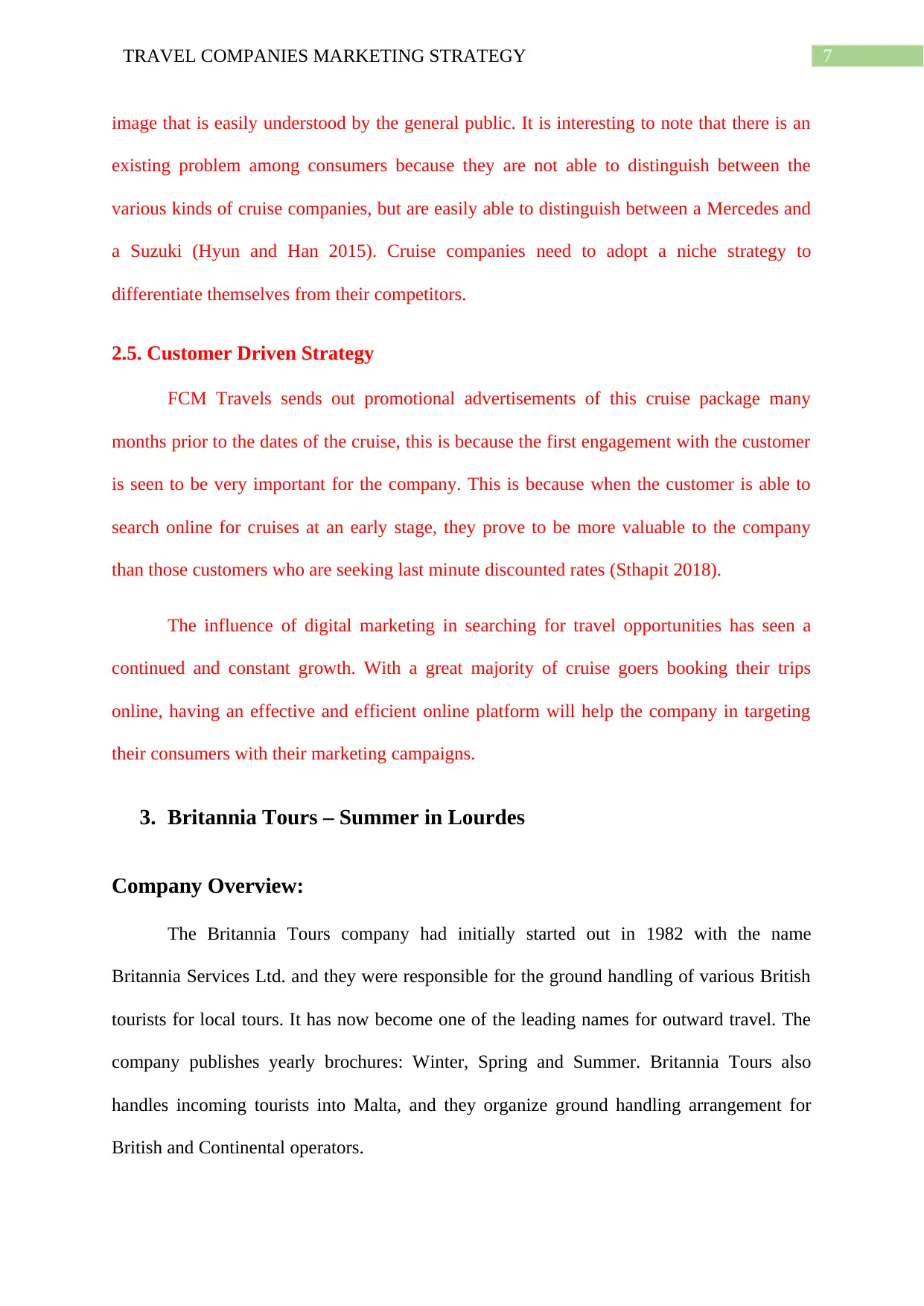
7TRAVEL COMPANIES MARKETING STRATEGY
image that is easily understood by the general public. It is interesting to note that there is an
existing problem among consumers because they are not able to distinguish between the
various kinds of cruise companies, but are easily able to distinguish between a Mercedes and
a Suzuki (Hyun and Han 2015). Cruise companies need to adopt a niche strategy to
differentiate themselves from their competitors.
2.5. Customer Driven Strategy
FCM Travels sends out promotional advertisements of this cruise package many
months prior to the dates of the cruise, this is because the first engagement with the customer
is seen to be very important for the company. This is because when the customer is able to
search online for cruises at an early stage, they prove to be more valuable to the company
than those customers who are seeking last minute discounted rates (Sthapit 2018).
The influence of digital marketing in searching for travel opportunities has seen a
continued and constant growth. With a great majority of cruise goers booking their trips
online, having an effective and efficient online platform will help the company in targeting
their consumers with their marketing campaigns.
3. Britannia Tours – Summer in Lourdes
Company Overview:
The Britannia Tours company had initially started out in 1982 with the name
Britannia Services Ltd. and they were responsible for the ground handling of various British
tourists for local tours. It has now become one of the leading names for outward travel. The
company publishes yearly brochures: Winter, Spring and Summer. Britannia Tours also
handles incoming tourists into Malta, and they organize ground handling arrangement for
British and Continental operators.
image that is easily understood by the general public. It is interesting to note that there is an
existing problem among consumers because they are not able to distinguish between the
various kinds of cruise companies, but are easily able to distinguish between a Mercedes and
a Suzuki (Hyun and Han 2015). Cruise companies need to adopt a niche strategy to
differentiate themselves from their competitors.
2.5. Customer Driven Strategy
FCM Travels sends out promotional advertisements of this cruise package many
months prior to the dates of the cruise, this is because the first engagement with the customer
is seen to be very important for the company. This is because when the customer is able to
search online for cruises at an early stage, they prove to be more valuable to the company
than those customers who are seeking last minute discounted rates (Sthapit 2018).
The influence of digital marketing in searching for travel opportunities has seen a
continued and constant growth. With a great majority of cruise goers booking their trips
online, having an effective and efficient online platform will help the company in targeting
their consumers with their marketing campaigns.
3. Britannia Tours – Summer in Lourdes
Company Overview:
The Britannia Tours company had initially started out in 1982 with the name
Britannia Services Ltd. and they were responsible for the ground handling of various British
tourists for local tours. It has now become one of the leading names for outward travel. The
company publishes yearly brochures: Winter, Spring and Summer. Britannia Tours also
handles incoming tourists into Malta, and they organize ground handling arrangement for
British and Continental operators.
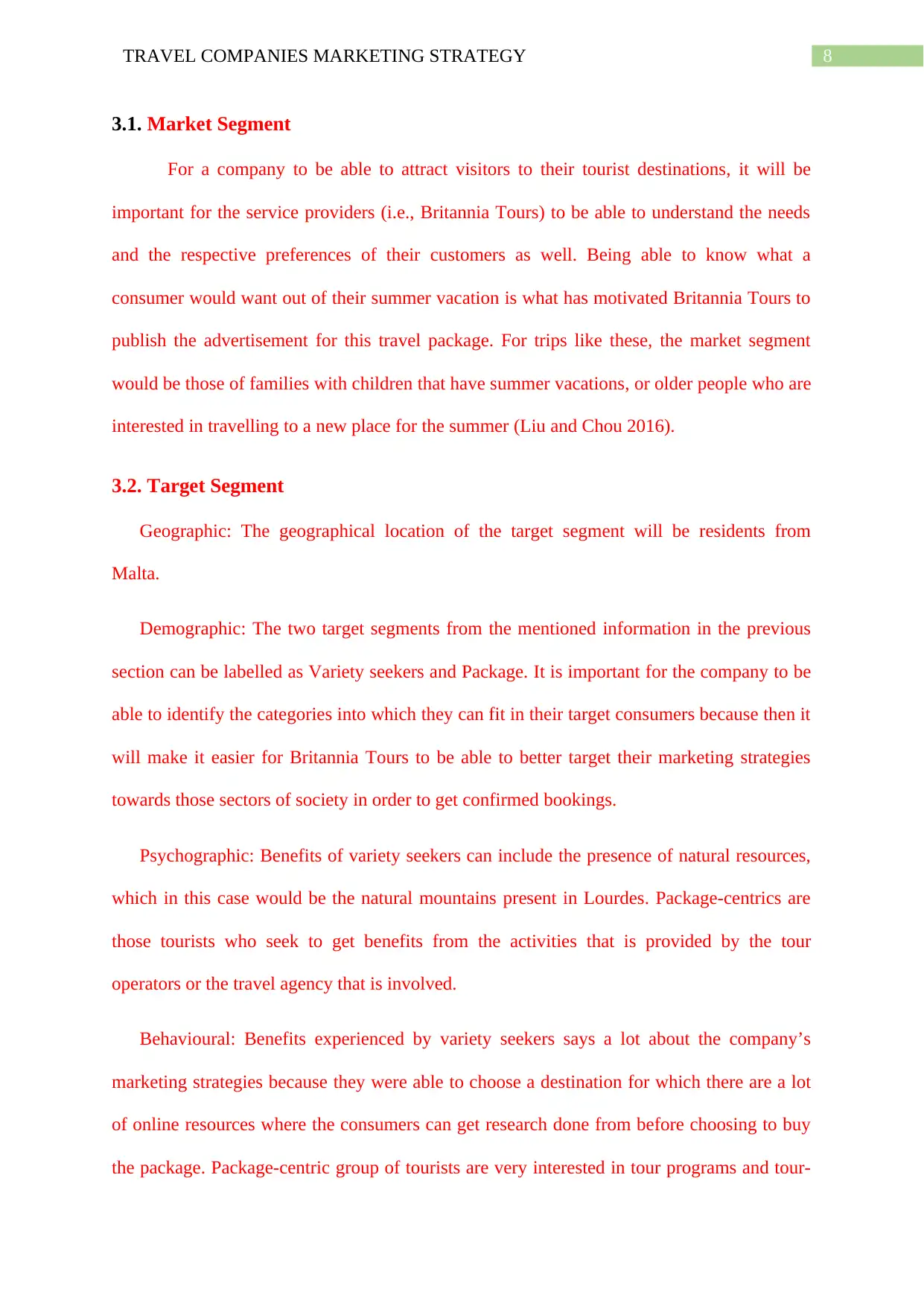
8TRAVEL COMPANIES MARKETING STRATEGY
3.1. Market Segment
For a company to be able to attract visitors to their tourist destinations, it will be
important for the service providers (i.e., Britannia Tours) to be able to understand the needs
and the respective preferences of their customers as well. Being able to know what a
consumer would want out of their summer vacation is what has motivated Britannia Tours to
publish the advertisement for this travel package. For trips like these, the market segment
would be those of families with children that have summer vacations, or older people who are
interested in travelling to a new place for the summer (Liu and Chou 2016).
3.2. Target Segment
Geographic: The geographical location of the target segment will be residents from
Malta.
Demographic: The two target segments from the mentioned information in the previous
section can be labelled as Variety seekers and Package. It is important for the company to be
able to identify the categories into which they can fit in their target consumers because then it
will make it easier for Britannia Tours to be able to better target their marketing strategies
towards those sectors of society in order to get confirmed bookings.
Psychographic: Benefits of variety seekers can include the presence of natural resources,
which in this case would be the natural mountains present in Lourdes. Package-centrics are
those tourists who seek to get benefits from the activities that is provided by the tour
operators or the travel agency that is involved.
Behavioural: Benefits experienced by variety seekers says a lot about the company’s
marketing strategies because they were able to choose a destination for which there are a lot
of online resources where the consumers can get research done from before choosing to buy
the package. Package-centric group of tourists are very interested in tour programs and tour-
3.1. Market Segment
For a company to be able to attract visitors to their tourist destinations, it will be
important for the service providers (i.e., Britannia Tours) to be able to understand the needs
and the respective preferences of their customers as well. Being able to know what a
consumer would want out of their summer vacation is what has motivated Britannia Tours to
publish the advertisement for this travel package. For trips like these, the market segment
would be those of families with children that have summer vacations, or older people who are
interested in travelling to a new place for the summer (Liu and Chou 2016).
3.2. Target Segment
Geographic: The geographical location of the target segment will be residents from
Malta.
Demographic: The two target segments from the mentioned information in the previous
section can be labelled as Variety seekers and Package. It is important for the company to be
able to identify the categories into which they can fit in their target consumers because then it
will make it easier for Britannia Tours to be able to better target their marketing strategies
towards those sectors of society in order to get confirmed bookings.
Psychographic: Benefits of variety seekers can include the presence of natural resources,
which in this case would be the natural mountains present in Lourdes. Package-centrics are
those tourists who seek to get benefits from the activities that is provided by the tour
operators or the travel agency that is involved.
Behavioural: Benefits experienced by variety seekers says a lot about the company’s
marketing strategies because they were able to choose a destination for which there are a lot
of online resources where the consumers can get research done from before choosing to buy
the package. Package-centric group of tourists are very interested in tour programs and tour-
⊘ This is a preview!⊘
Do you want full access?
Subscribe today to unlock all pages.

Trusted by 1+ million students worldwide
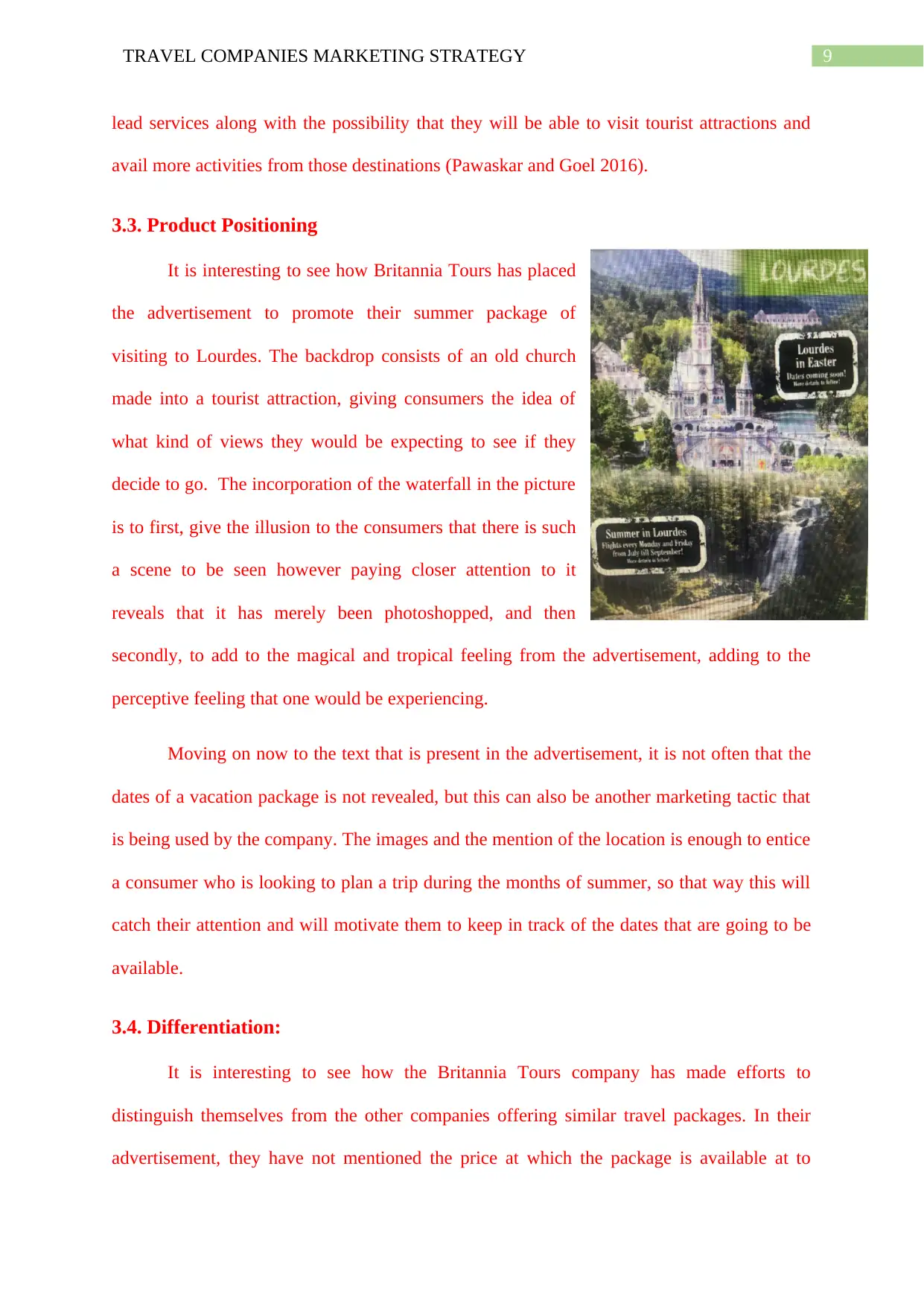
9TRAVEL COMPANIES MARKETING STRATEGY
lead services along with the possibility that they will be able to visit tourist attractions and
avail more activities from those destinations (Pawaskar and Goel 2016).
3.3. Product Positioning
It is interesting to see how Britannia Tours has placed
the advertisement to promote their summer package of
visiting to Lourdes. The backdrop consists of an old church
made into a tourist attraction, giving consumers the idea of
what kind of views they would be expecting to see if they
decide to go. The incorporation of the waterfall in the picture
is to first, give the illusion to the consumers that there is such
a scene to be seen however paying closer attention to it
reveals that it has merely been photoshopped, and then
secondly, to add to the magical and tropical feeling from the advertisement, adding to the
perceptive feeling that one would be experiencing.
Moving on now to the text that is present in the advertisement, it is not often that the
dates of a vacation package is not revealed, but this can also be another marketing tactic that
is being used by the company. The images and the mention of the location is enough to entice
a consumer who is looking to plan a trip during the months of summer, so that way this will
catch their attention and will motivate them to keep in track of the dates that are going to be
available.
3.4. Differentiation:
It is interesting to see how the Britannia Tours company has made efforts to
distinguish themselves from the other companies offering similar travel packages. In their
advertisement, they have not mentioned the price at which the package is available at to
lead services along with the possibility that they will be able to visit tourist attractions and
avail more activities from those destinations (Pawaskar and Goel 2016).
3.3. Product Positioning
It is interesting to see how Britannia Tours has placed
the advertisement to promote their summer package of
visiting to Lourdes. The backdrop consists of an old church
made into a tourist attraction, giving consumers the idea of
what kind of views they would be expecting to see if they
decide to go. The incorporation of the waterfall in the picture
is to first, give the illusion to the consumers that there is such
a scene to be seen however paying closer attention to it
reveals that it has merely been photoshopped, and then
secondly, to add to the magical and tropical feeling from the advertisement, adding to the
perceptive feeling that one would be experiencing.
Moving on now to the text that is present in the advertisement, it is not often that the
dates of a vacation package is not revealed, but this can also be another marketing tactic that
is being used by the company. The images and the mention of the location is enough to entice
a consumer who is looking to plan a trip during the months of summer, so that way this will
catch their attention and will motivate them to keep in track of the dates that are going to be
available.
3.4. Differentiation:
It is interesting to see how the Britannia Tours company has made efforts to
distinguish themselves from the other companies offering similar travel packages. In their
advertisement, they have not mentioned the price at which the package is available at to
Paraphrase This Document
Need a fresh take? Get an instant paraphrase of this document with our AI Paraphraser
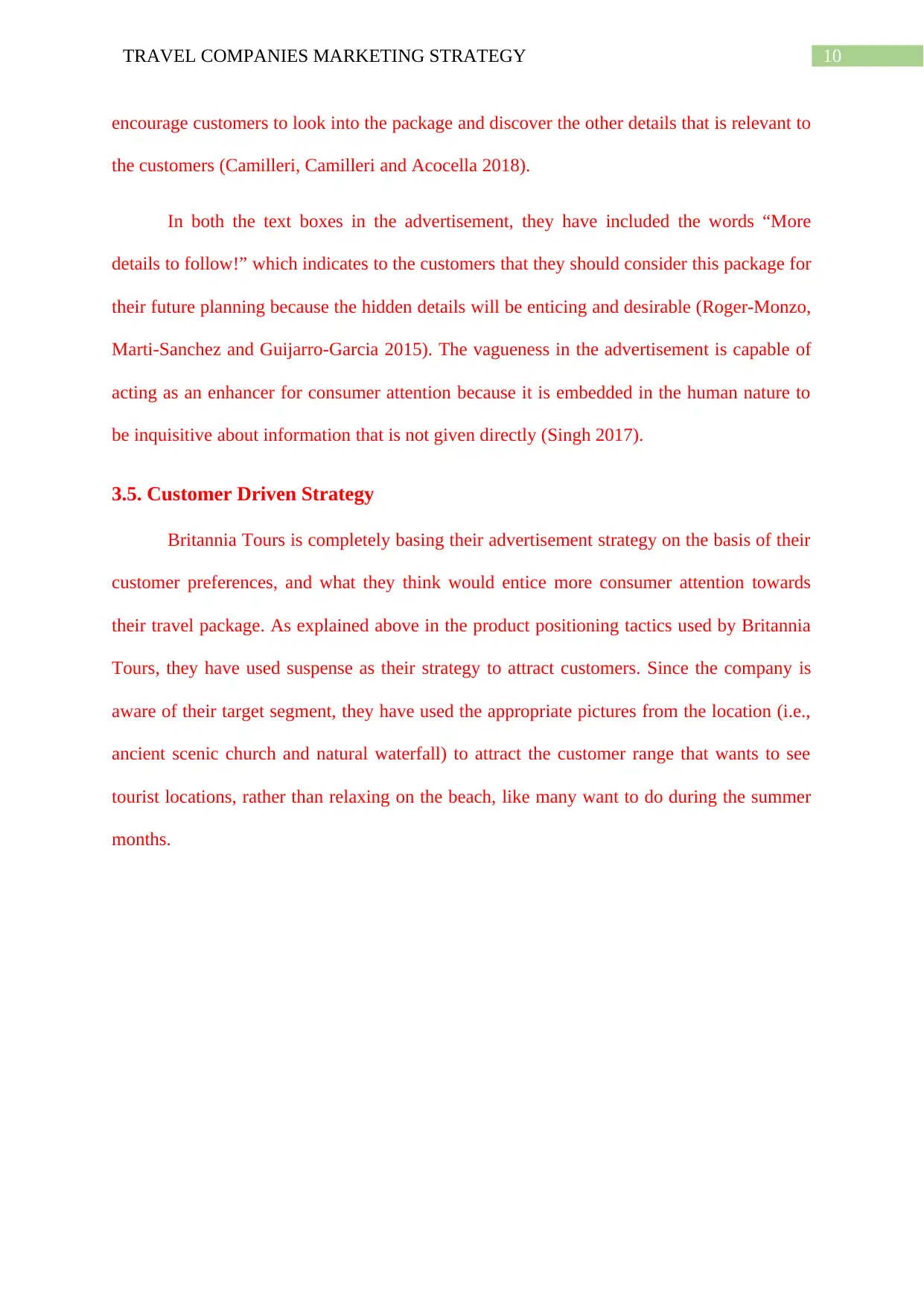
10TRAVEL COMPANIES MARKETING STRATEGY
encourage customers to look into the package and discover the other details that is relevant to
the customers (Camilleri, Camilleri and Acocella 2018).
In both the text boxes in the advertisement, they have included the words “More
details to follow!” which indicates to the customers that they should consider this package for
their future planning because the hidden details will be enticing and desirable (Roger-Monzo,
Marti-Sanchez and Guijarro-Garcia 2015). The vagueness in the advertisement is capable of
acting as an enhancer for consumer attention because it is embedded in the human nature to
be inquisitive about information that is not given directly (Singh 2017).
3.5. Customer Driven Strategy
Britannia Tours is completely basing their advertisement strategy on the basis of their
customer preferences, and what they think would entice more consumer attention towards
their travel package. As explained above in the product positioning tactics used by Britannia
Tours, they have used suspense as their strategy to attract customers. Since the company is
aware of their target segment, they have used the appropriate pictures from the location (i.e.,
ancient scenic church and natural waterfall) to attract the customer range that wants to see
tourist locations, rather than relaxing on the beach, like many want to do during the summer
months.
encourage customers to look into the package and discover the other details that is relevant to
the customers (Camilleri, Camilleri and Acocella 2018).
In both the text boxes in the advertisement, they have included the words “More
details to follow!” which indicates to the customers that they should consider this package for
their future planning because the hidden details will be enticing and desirable (Roger-Monzo,
Marti-Sanchez and Guijarro-Garcia 2015). The vagueness in the advertisement is capable of
acting as an enhancer for consumer attention because it is embedded in the human nature to
be inquisitive about information that is not given directly (Singh 2017).
3.5. Customer Driven Strategy
Britannia Tours is completely basing their advertisement strategy on the basis of their
customer preferences, and what they think would entice more consumer attention towards
their travel package. As explained above in the product positioning tactics used by Britannia
Tours, they have used suspense as their strategy to attract customers. Since the company is
aware of their target segment, they have used the appropriate pictures from the location (i.e.,
ancient scenic church and natural waterfall) to attract the customer range that wants to see
tourist locations, rather than relaxing on the beach, like many want to do during the summer
months.
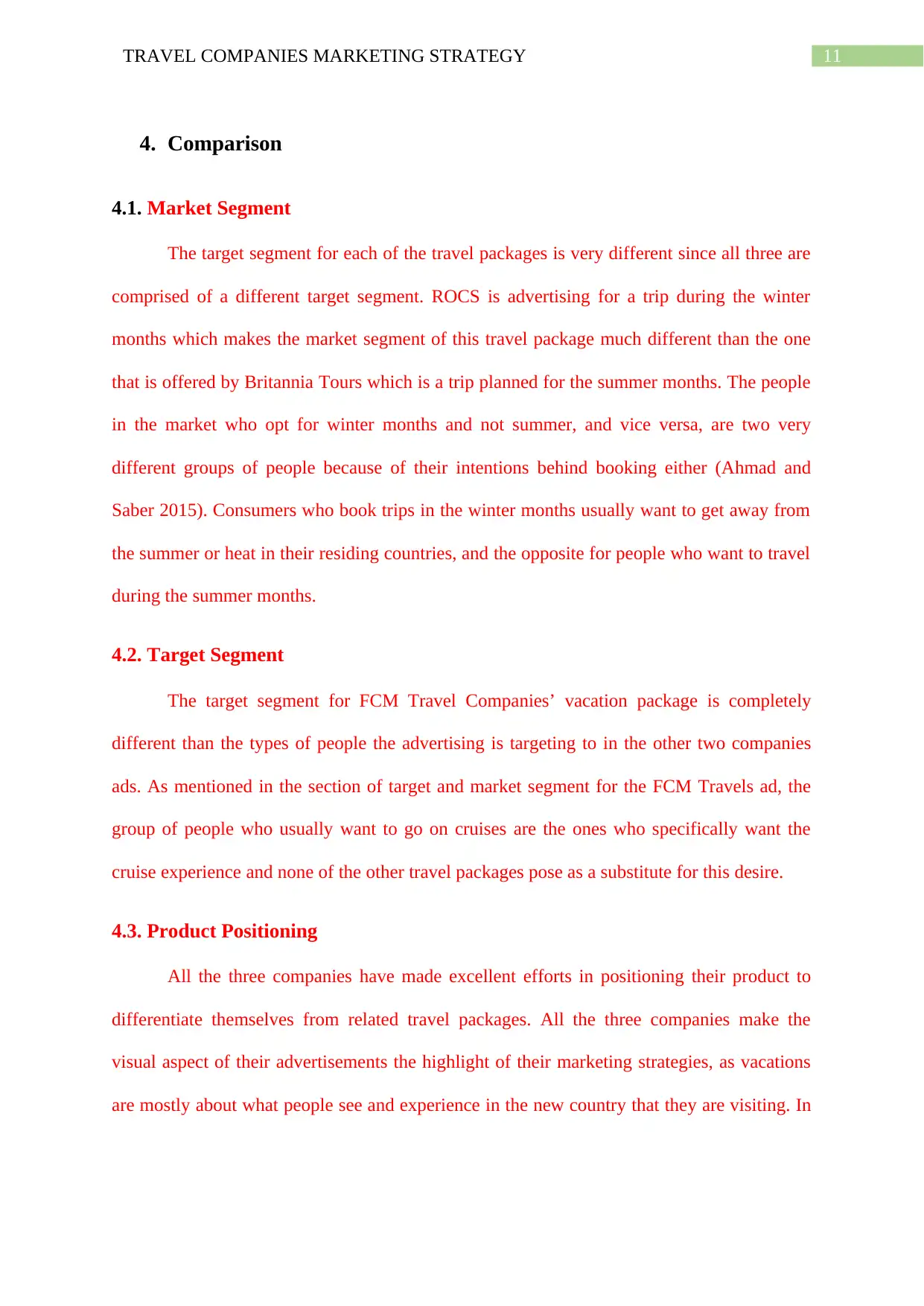
11TRAVEL COMPANIES MARKETING STRATEGY
4. Comparison
4.1. Market Segment
The target segment for each of the travel packages is very different since all three are
comprised of a different target segment. ROCS is advertising for a trip during the winter
months which makes the market segment of this travel package much different than the one
that is offered by Britannia Tours which is a trip planned for the summer months. The people
in the market who opt for winter months and not summer, and vice versa, are two very
different groups of people because of their intentions behind booking either (Ahmad and
Saber 2015). Consumers who book trips in the winter months usually want to get away from
the summer or heat in their residing countries, and the opposite for people who want to travel
during the summer months.
4.2. Target Segment
The target segment for FCM Travel Companies’ vacation package is completely
different than the types of people the advertising is targeting to in the other two companies
ads. As mentioned in the section of target and market segment for the FCM Travels ad, the
group of people who usually want to go on cruises are the ones who specifically want the
cruise experience and none of the other travel packages pose as a substitute for this desire.
4.3. Product Positioning
All the three companies have made excellent efforts in positioning their product to
differentiate themselves from related travel packages. All the three companies make the
visual aspect of their advertisements the highlight of their marketing strategies, as vacations
are mostly about what people see and experience in the new country that they are visiting. In
4. Comparison
4.1. Market Segment
The target segment for each of the travel packages is very different since all three are
comprised of a different target segment. ROCS is advertising for a trip during the winter
months which makes the market segment of this travel package much different than the one
that is offered by Britannia Tours which is a trip planned for the summer months. The people
in the market who opt for winter months and not summer, and vice versa, are two very
different groups of people because of their intentions behind booking either (Ahmad and
Saber 2015). Consumers who book trips in the winter months usually want to get away from
the summer or heat in their residing countries, and the opposite for people who want to travel
during the summer months.
4.2. Target Segment
The target segment for FCM Travel Companies’ vacation package is completely
different than the types of people the advertising is targeting to in the other two companies
ads. As mentioned in the section of target and market segment for the FCM Travels ad, the
group of people who usually want to go on cruises are the ones who specifically want the
cruise experience and none of the other travel packages pose as a substitute for this desire.
4.3. Product Positioning
All the three companies have made excellent efforts in positioning their product to
differentiate themselves from related travel packages. All the three companies make the
visual aspect of their advertisements the highlight of their marketing strategies, as vacations
are mostly about what people see and experience in the new country that they are visiting. In
⊘ This is a preview!⊘
Do you want full access?
Subscribe today to unlock all pages.

Trusted by 1+ million students worldwide
1 out of 16
Related Documents
Your All-in-One AI-Powered Toolkit for Academic Success.
+13062052269
info@desklib.com
Available 24*7 on WhatsApp / Email
![[object Object]](/_next/static/media/star-bottom.7253800d.svg)
Unlock your academic potential
Copyright © 2020–2025 A2Z Services. All Rights Reserved. Developed and managed by ZUCOL.





